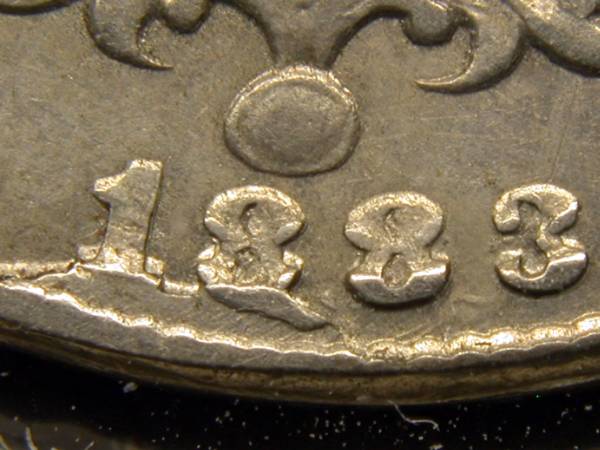
Mouse over the image to highlight the overdate
The 1883/2 Shield
Nickel Web Pages
FS5c-013.2 F-10 S1-5003
B2526 PM-18V.3
On this page, we will take a look at the 1883/2 FS5c-013.2 (F-10) shield nickel. Here is a picture of the date area of a fairly nice example.

Mouse over the image to highlight the overdate
This variety has the underlying 2 approximately centered between the second 8 and the 3. In this photo, you can see the curved baseline of the 2, and a little bit of the downward stroke of the 2 between the arms of the 3. Also visible is the chip of the base of an underlying 8 to the left of the second 8, approximately halfway between the two eights and in line with the baseline of the eights.
This variety is the least dramatic of the three traditionally recognized 1883/2 varieties (FS5c-013, FS5c-013.1, and FS5c-013.2). Most of the time, only the remnants of the base of the 2 are visible. According to Walter Breen's Complete Encyclopedia of U.S. and Colonial Coins, specimens of this variety do exist that show most of the 2. They are extremely rare. I have never seen a specimen with a complete underlying 2, but the first picture below comes close. Because this variety is not dramatic it can occasionally be cherrypicked.
The cud in the picture above (underneath the "18") is characteristic of this variety and may be used for diagnostic purposes. However, lack of the cud does not necessarily mean that the coin is not FS5c-013.2, because this variety is available in several die stages. The die stages range from nothing at all under the 18, through a die break under the 18, to a retained cud (pictured above), and finally to a full cud.
Here is a series of pictures showing the evolution of the cud for this variety.
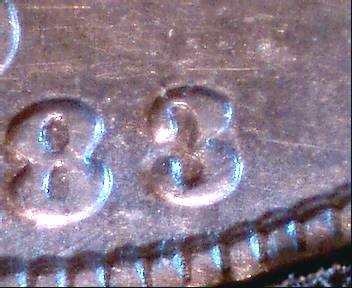 |
This early die stage FS-013.2 showing more of the body of the underlying two is difficult to capture in a picture because there is not that much metal left. Nevertheless, if you can get the light at the correct angle quite a bit of the underlying 2 becomes visible. Here you can clearly see the heavy base, part of the downstroke, and part of the top curve of the 2. Use your imagination a little bit! This picture was taken with a microscope. |
|
F-10a
|
|
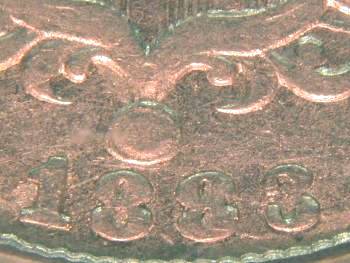 |
Same coin as above, photo taken with a camera. |
|
F-10a
|
|
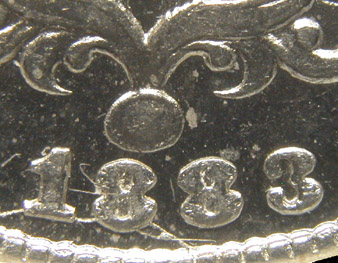 |
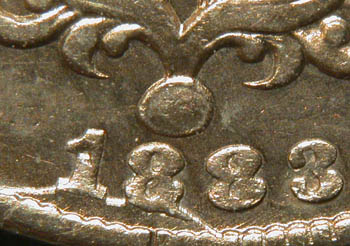 |
|
F-10b
|
F-10b+
|
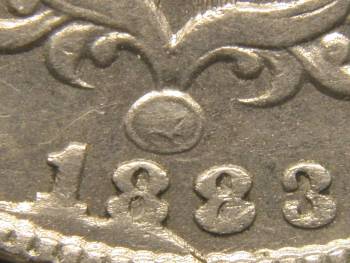 |
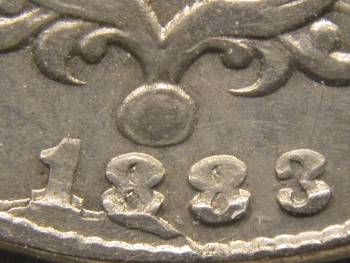 |
|
F-10c
|
F-10c+
|
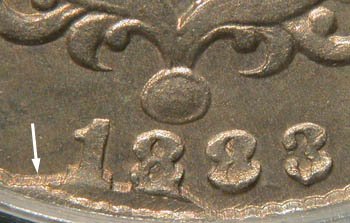 |
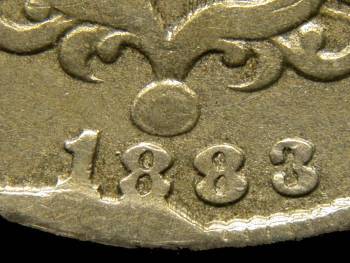 |
|
F-10c++
|
F-10d
|
Fletcher die stages are catalogued as follows:
| F-10a | No die break, preferably shows most of the underlying 2. (examples: 1st and 2nd photos above) |
| F-10b | Die crack under 18. (3rd photo above) |
| F-10b+ | Die crack under 18 progressing towards die break. Die break is especially apparent under the first 8. (4th photo above) |
| F-10c | Retained cud under 18. (example: 5th photo above) |
| F-10c+ | Retained cud under 18, even more metal broke off the die just below the 8 (example: 6th photo above) |
| F-10c++ | Full cud starting form, arrow points to mssing denticles (example: 7th photo above) |
| F-10d | Full cud under 18. "Unknown" in Fletcher - discovered 1999 by C. Pilliod (example: 8th photo above) |
Now let's take a look at an extreme closeup view of the base of the 2 in this variety.
In the image to the left below, the curved shapes to the left and right are the 8 and the 3. The base of the 2 can be seen between them.
Just for fun, I've included a photo of an 1882 clear 2 to the right below. Look at the shape of the base of the 2, and match it up to the shape shown in the closeup.
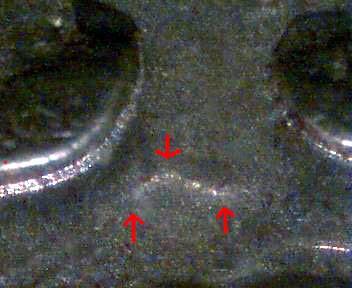
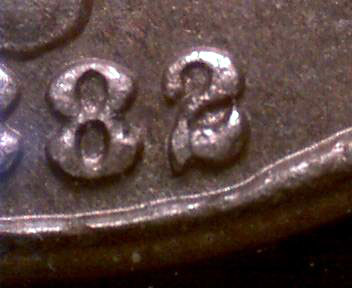
For reference, here are pictures of the full obverse and reverse of FS5c-013.2.
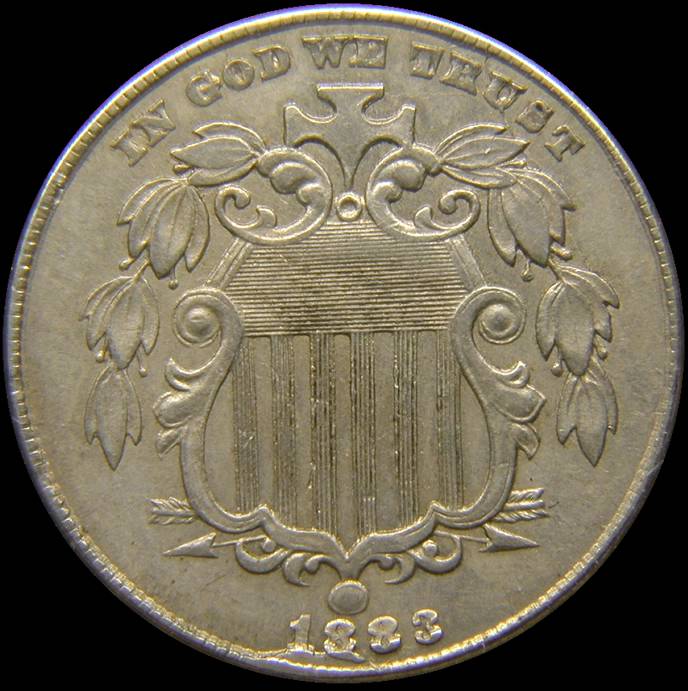
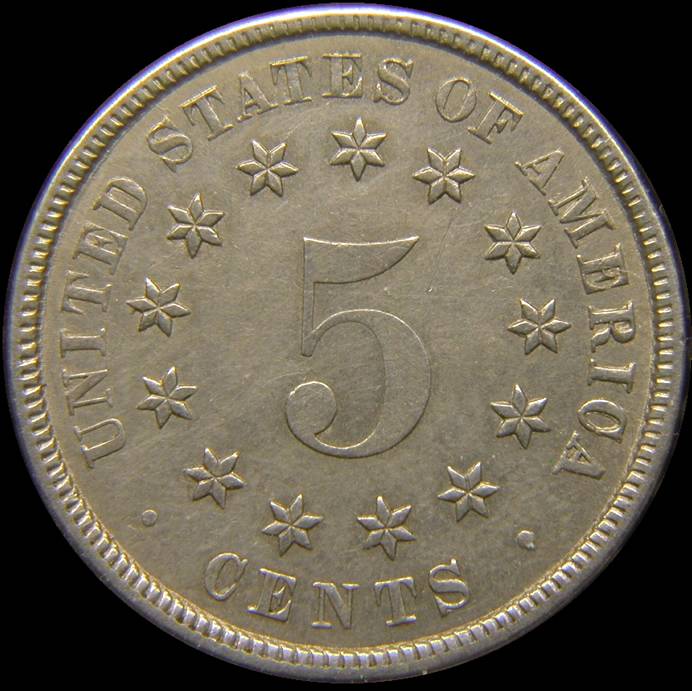
All text and images for the 1883/2 Shield Nickel website are copyright (C) 2002, 2003, 2004, 2005, 2015 by Howard Spindel